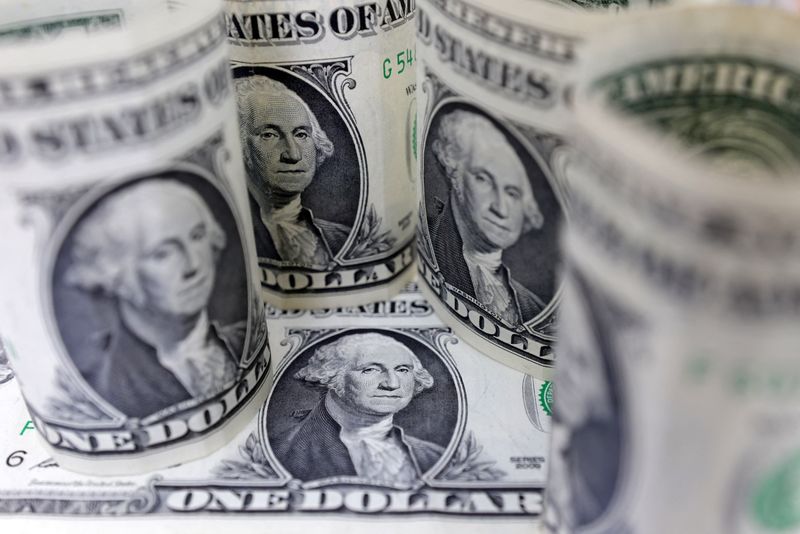By Kevin Buckland
TOKYO (Reuters) -The U.S. dollar fell from two-month highs hit overnight versus its major peers after signs of weakness in the labour market boosted the case for quicker Federal Reserve rate cuts.
Despite that, the dollar on Friday remained on track for a second straight weekly advance after surprisingly strong monthly payrolls figures last week prompted traders to take bets for a half-percentage-point cut at the Fed’s next policy meeting off the table.
The market’s interpretation of Thursday’s surge in initial jobless claims was complicated by an uptick in the consumer price index (CPI) the same day, which served as a reminder that restrictive monetary policy may still be required to bring inflation under control.
Bets for a quarter-point Fed rate cut on Nov. 7 increased to 83.3% from 80.3% a day earlier, with the remaining odds for policy to stay steady, the CME Group’s (NASDAQ:) FedWatch Tool showed early in the Asian day. A week earlier, there was a 32.1% chance of a half-point reduction and 67.9% probability of a quarter-point cut.
The , which measures the currency against six peers, was flat at 102.89 as of 0543 GMT, but down 0.28% from 103.17 on Thursday, which was its highest level since Aug. 15. For the week, the index is on track for 0.41% advance, building on the previous week’s 2.06% surge.
While the Fed has signalled a shift in its focus towards full employment over price stability, investors had been looking to the CPI print for confirmation that inflation was coming under control.
“It seems that ‘Mr Market’ is having as much trouble balancing employment and inflation as the Fed are,” said Michael Brown, senior research strategist at Pepperstone.
And while the weekly jobless claims data was skewed by Hurricane Helene, next week’s data will be impacted by Hurricane Milton, which will in turn raise downside risks for the next monthly payrolls report, he said.
“Put simply, incoming U.S. economic data is about to become very, very messy over the next quarter or so.”
Comments from Fed officals on Thursday pointed to a divide in views, with Chicago Fed President Austan Goolsbee saying the “vast majority” of Fed policy makers expect rates will “gradually come down a fair amount to something well below where they are today”, while Atlanta Fed President Raphael Bostic said he is “definitely open to” skipping a rate cut in November.
“It’s volatile, but momentum-wise, the direction for the dollar remains up for now,” said Shoki Omori, chief Japan desk strategist at Mizuho Securities.
At the same time, bets for the pace of Fed easing “could fluctuate pretty easily” depending on incoming data, he said.
The dollar added 0.04% to 148.64 yen, inching back towards Thursday’s high of 149.58 yen, a level previously not seen since Aug. 2.
A move above 150 is unlikely in the near term though, Omori said, as “150 is really the level that policy makers are going to be worried about, because if you go past that, carry traders are going to come back.”
The euro eased slightly to $1.0934 after bouncing back overnight from a two-month low at $1.090025.
Sterling declined 0.08% to $1.3050, edging back toward the previous session’s low of $1.3011, its weakest since Sept. 11.
The Australian dollar held firm at $0.67395 after rebounding from its lowest since Sept. 16 at $0.6702 on Thursday. It’s on track for a 0.75% weekly slide.

Australia’s currency has been buffeted in recent days by a waxing and waning in stimulus expectations in the nation’s biggest trading partner, China. China’s finance ministry is scheduled to hold a news conference on fiscal policy on Saturday.
The New Zealand dollar added 0.11% to $0.6101, after slumping as low as $0.6050 on Thursday for the first time since Aug. 19. For the week, it has lost 1.06% with the central bank on Wednesday slashing rates by a half point and hinting of further cuts to come.


